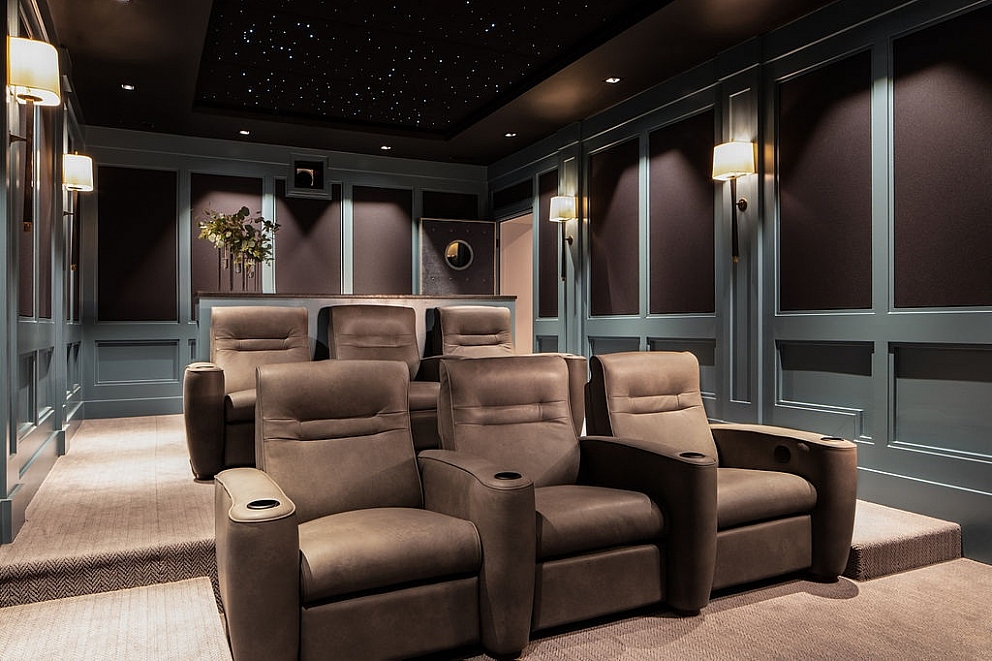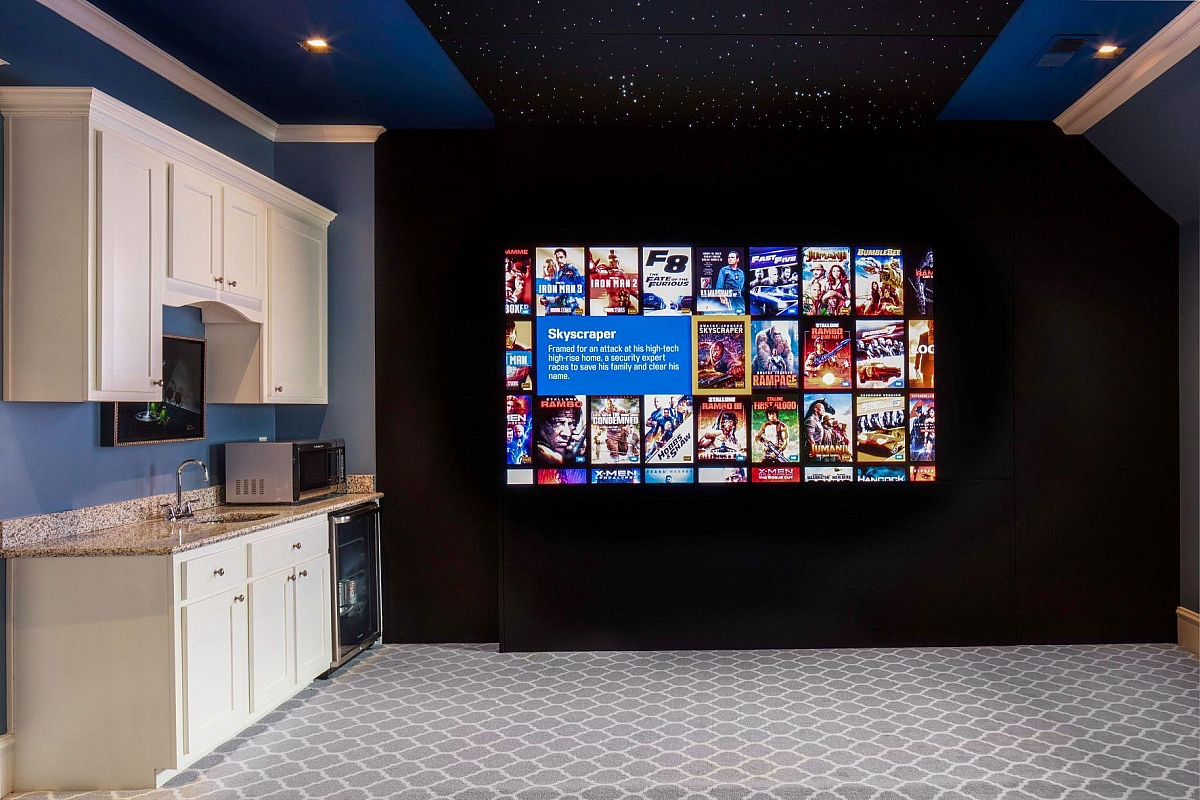The process of creating a home theater or media room is a popular idea for homeowners. It allows you to enjoy movies, TV shows, and games in a cinematic setting at home. It's a chance to escape and relax with your favorite entertainment.
With many choices for seating, screens, ambiance, and acoustics, creating a home entertainment space can be overwhelming. This guide will help you make key decisions for a versatile media room or dedicated home theater.
Understanding the Experience: Media Room vs. Home Theater
The first decision you'll need to make is whether you want to create a media room or a home movie theater. Both spaces serve similar purposes but offer very different experiences.
A media room offers a versatile design. It’s a space where you can watch TV, play video games, listen to music, or even host parties. Media rooms often feature multiple TVs, which allow you to watch different shows or games simultaneously. For the gamers out there, check out how we turn media rooms into the ultimate gaming space.
Media rooms typically have a casual and laid-back vibe. They have comfortable seating options such as sectionals, couches, or loungers. These media room furniture seating options make it easy for people to relax and unwind in the space.
On the other hand, a home theater is all about recreating the movie theater experience. This space immerses film lovers in the cinematic world without leaving home. A home theater has a projector and screen for big, clear images that make you feel like you're part of the story.
We create a room that enhances your viewing experience. It features soundproofing, dark curtains, and comfortable theater seating. This setup makes you feel like you are at the movies.
The choice between a media room and a home theater depends on how you intend to use the space. If you want a multipurpose room where you can enjoy a variety of entertainment options, a media room might be the right choice. But if you’re a cinephile who values the ultimate film experience, a home theater is the way to go.

Projectors & Screens vs. TVs: Choosing the Right Display
One of the most important decisions in creating your home entertainment space is choosing between a projector and screen setup or a large TV. Each option has its advantages, and the right choice depends on your priorities.
Projectors and Screens are the hallmark of a true home theater. They offer a larger display size than most TVs, which is essential for creating that immersive, cinema-like experience. With the right setup and controlled lighting, projectors deliver stunning picture quality.
The larger screen size allows you to replicate the feeling of sitting in a movie theater, where the visuals dominate your field of view. This setup is ideal for dedicated home theaters where movies, TV shows, and sports are the main focus.

Seating & Room Layout: The Foundation of Your Space
Once you’ve decided between a media room and a home theater, the next step is planning the seating and room layout. This is where the functionality of the space comes together, and careful planning is essential to ensure a comfortable and enjoyable experience. Read our past blog on how we use VR technology to help clients, home builders, and interior designers make aesthetic decisions when planning the foundation of a space.
Start by establishing the primary use of the room. Is it going to be a versatile media room where the family gathers to watch TV and play games, or a dedicated home theater where you’ll enjoy movies in the best possible way? This decision will influence every other aspect of the room’s design, particularly the seating arrangement.
A common mistake is choosing a screen that’s too large for the space, which can make viewing uncomfortable. Instead, let your seating guide the screen size. For example, if you prefer sitting in the middle of the theater, measure the distance between your seat and the screen, then select a screen size that provides a similar viewing experience. This ensures that the screen isn’t overwhelming, and it also helps maintain the picture quality by preventing you from sitting too close to a large screen.
The number of seats in your home theater or media room will depend on how many people will regularly use the space. If you’re designing a room for your family, think about the maximum number of people who will be watching at any given time. Only include as many seats as you need based on regular use; do not fill the room with seats that you won't use. Instead, focus on creating a comfortable layout that allows for easy movement and optimal viewing for everyone.

When choosing between home theater seating and couches or loungers, consider the type of content you’ll be watching and your personal comfort preferences. Theater seating enhances long viewing sessions with features such as reclining seats and built-in cup holders. These seats are ideal for home theaters where movies are the main focus.

However, if you’ll use the space for various activities, choose couches or loungers instead. They offer more flexibility and are often more comfortable for casual viewing. Couches can also accommodate more people, making them a good choice for larger families or those who like to entertain guests.
Finally, think about the other features you want to include in the room, such as a wet bar, concession stand, or storage space. Plan these elements carefully to enhance the room’s functionality without cluttering the space.
Creating the Perfect Ambiance: Acoustics, Lighting, and More
The ambiance of your home theater or media room is what transforms it from a simple viewing space into a fully immersive experience. This includes using soundproofing, controlling lighting, and other design features to improve the overall atmosphere of a space.
Room acoustical treatments are essential for achieving the best sound quality in your home theater. These treatments control sound waves in the room, reduce echoes, and improve clarity. Proper acoustics ensure that dialogue is crisp, sound effects are impactful, and music is clear and enveloping. Without these treatments, sound can become muddled, making it difficult to hear important details in your movies or TV shows.

Soundproofing is another key aspect of creating the perfect ambiance. Soundproofing helps contain the sound within the room, preventing it from disturbing other areas of your home. This is especially important if your home theater sits near bedrooms or other quiet spaces.
Effective soundproofing can involve adding extra insulation, installing specialized doors, and using materials that absorb sound. By soundproofing your home theater, you can enjoy movies at any volume without worrying about waking the kids or disturbing other family members. If you're interested in learning about top ideas to hide your tech, we've got a blog post that covers this topic.

Lighting features play a crucial role in your home, but especially in setting the mood for your home theater or media room. The goal is to create a lighting setup that enhances the viewing experience without causing distractions. Blackout curtains or motorized shades are a must for controlling natural light, especially if you’re using a projector. Adjust these shades to block out light completely or let in just the right amount, depending on your needs.
For added ambient light, consider installing starry ceilings or other decorative lighting features. Starry ceilings are a popular choice in home theaters, as they mimic the night sky and add a touch of magic to the room. They also contribute to the room’s acoustics by diffusing sound and reducing echoes. Use LED strips, recessed lighting, and sconces to create a warm, inviting atmosphere.

If you’re trying to replicate the look and feel of a commercial cinema, think about including cinematic elements like curtains, thick carpet, and movie posters. These details can make your home theater feel more authentic and enhance the overall experience. Automated lighting is another feature that can add to the cinematic experience. With automated lighting, you can program the lights to dim or brighten automatically when the movie starts, pauses, or ends, adding a professional touch to your home theater.
Planning for High-Quality Content: The Finishing Touch
After investing in a high-end home theater setup, it’s important to ensure that you’re getting the most out of it by choosing high-quality content. While streaming services are convenient, they may not always offer the best picture or sound quality, which can diminish the experience in a state-of-the-art home theater.

For the best results, consider sourcing your content from premium platforms like Kaleidescape. Kaleidescape offers a vast library of movies and TV shows in ultra-high-definition with lossless audio, providing a level of quality that streaming services can’t match. By using a service like Kaleidescape, you can fully experience the capabilities of your home theater system, with visuals and sound that rival those of commercial cinemas.
Additionally, be mindful of the types of content you’re watching. If you’ve invested in a projector and screen setup, avoid low-resolution content that can appear pixelated or blurry when projected on a large screen. Instead, choose 4K or 8K content that takes full advantage of your home theater’s capabilities.
Final Thoughts
Creating the perfect home theater or media room is a blend of art and science. It requires careful planning, thoughtful design, and attention to detail to achieve a space that meets your entertainment needs and enhances your home’s value. Whether you’re leaning towards a versatile media room or a dedicated home theater, understanding these key elements will help you make informed decisions and create a space that provides countless hours of enjoyment.
By focusing on the experience you want to create, choosing the home integration company, right equipment, planning the seating and layout, and paying attention to ambiance and content, you can design a home theater or media room that exceeds your expectations. Learn what to expect from your project when you choose Miestro to elevate your space.















